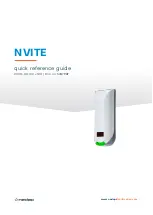
3 - PCIe Card & Interfaces
The MicroDock
22
Creative Professional
Front Panel Connections
Preamp Section
Phantom Power
Caution:
Some
microphones (notably
ribbon types) cannot
tolerate phantom power
and may be damaged.
Check the specifications
and requirements of your
microphone before using
phantom power.
The front panel mono Mic/Line inputs A & B can be used as balanced microphone
inputs, hi-Z guitar pickup inputs, or line level inputs. The Neutrik combination jack
accepts microphones using a standard XLR connector or line level/hi-Z inputs (such as
an electric guitar) using a standard 1/4 inch TRS/TS connector.
Each preamp has a level control which sets the preamp gain from 0dB to +65dB for the
XLR input and from -15dB to +50dB for the Hi-Z line input. The line markings around
the knobs are calibrated in 10dB increments. The heavy hash marks on the gain
controls indicate unity analog gain to the converter inputs (~5dBV input = 0dBFS
output).
A phantom power switch e48 volt phantom power supplied to both micro-
phones. A red LED illuminates to indicate phantom power is enabled. The audio mutes
for a second when phantom power is turned on. After turning phantom power off, wait
two full minutes before recording to allow the DC bias to drain.
See “Phantom Power”
for additional information.
Each microphone input has its own input level meters and clipping indicators. The
LED meters indicate signal presence. Adjust the input gain so that the yellow LEDs are
illuminated. The red Clip LED indicates that the gain is set too high and the signal is
clipping the input. These LEDs monitor the signal directly at the analog-to-digital
converters and before any processing by the rest of the system. When setting the levels
for signals being sent into the MicroDock, the red clip indicator should never flash.
S/PDIF Digital Audio Input & Output
RCA phono jacks are standard connectors used for coaxial S/PDIF (Sony/Philips
Digital InterFace) connections. Each jack carries two channels of digital audio. The
MicroDock sends or receives digital audio data at 44.1k, 48k, 88.2k, 96k, 176.4k or
192k sample rates. Data is always transmitted at 24-bits, but lower word widths can be
read. The word clock contained in the input data stream can be used as a word clock
source.
See “System Settings”.
S/PDIF digital I/O can be used for the reception and/ or transmission of digital data
from external digital devices such as a DAT, external analog-to-digital converter or an
external signal processor equipped with digital inputs and outputs.
The S/PDIF out can be configured in either Professional or Consumer mode in the
Session Settings menu. The MicroDock can also send and receive AES/EBU digital
audio through the use of a cable adapter.
See “Cables - balanced or unbalanced?”
for
details.
















































